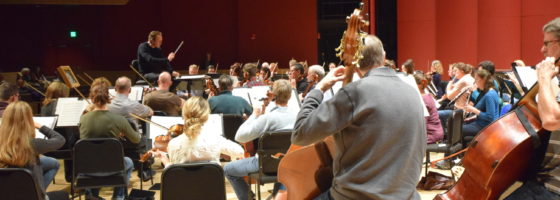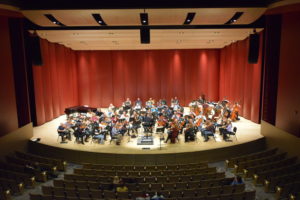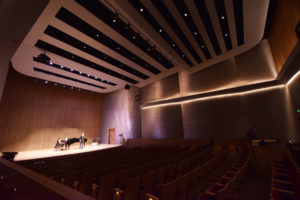Acoustics to Support Academic Performing Arts
Russ Cooper | February 1, 2018

With the grand opening of the Ent Center, the University of Colorado at Colorado Springs is giving the community a first-class performing arts facility for performing, teaching and learning. Students and teachers are the primary users and they have unique needs when it comes to learning how to play and perform. The ability to hear themselves and listen to others onstage is vital to success and acoustics make a big impact.
A Supportive Learning Environment
There are many ways we as acousticians can tailor a space to meet the acoustic requirements of an academic performance facility. This type of academic setting must have a supportive aural environment on stage so that students can hone their craft by listening carefully to themselves and other musicians. Acousticians do this by managing the arrival time of early sound reflections off nearby surfaces and achieving a balanced sound on stage.
Jaffe Holden designed a special adjustable acoustic shell for the 750-seat Shockley-Zalabek Theater to support the learning musician’s need for onstage hearing. The shell allows just the right amount of low frequency sound to pass through, reflect off the stage house walls, and return to the musician onstage. The shell’s reflective surface can be configured to support large orchestras and small jazz ensembles.

Acousticians ensure appropriate sound isolation is in place so adjacent spaces can be used simultaneously.
Stopping Sound Bleed
Academic learning environments generally have multiple performance spaces and rooms in use at the same time. As acousticians, we can ensure appropriate sound isolation is in place so that music from a practice room can’t be heard during a performance in the recital hall and that footfall from the dance studio does not become a distraction to classrooms or recording studios. The Ent Center has a tight footprint with complex box-in-box construction techniques. Coupled with composite masonry and hidden acoustic isolation joints, performance spaces can be used simultaneously to meet schedule and program needs.

Academic performance spaces require supportive acoustics
Making it Multi-Use
The Ent Center provides students and faculty with a wide range of programming and performance types. Many spaces were designed to be multi-use and Jaffe Holden focused on creating a flexible aural environment to support learning and playing. For example, an adjustable acoustic system in the Shockley-Zalabek Theater changes the room’s acoustics at the touch of a button to suit the performance type. The room’s natural acoustic helps classical musicians and the audience hear every individual string of the violin. When banners are deployed, sound is dampened and the musician playing amplified music has the best aural environment in which to sharpen their skills. Students gain confidence and exposure to professional spaces suited for their instruments.
These days, an academic performing arts facility needs a strong acoustic design to properly support the unique needs of students and faculty. Acoustics influence onstage hearing, protect against noisy distractions, and create a great aural environment to build confidence in young musicians.

Comments